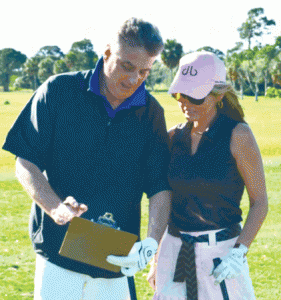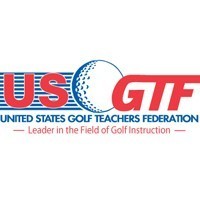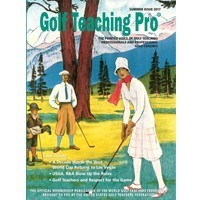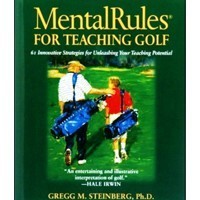Blog
Avis, Budget Offering World Cup Deals
USGTF Launches Re-Designed Site
Summer Edition of Magazine Now Out
“PRO” File – Touring Professional Brian Harman
Go Slow Like Brooks Koepka
Steinberg Book Available to USGTF Members
U.S. OPEN
An Organized Pro Equals Happy Students
 Hap Hazard is a golf teaching pro at Bucket O’ Balls Driving Range. He’s normally on time for his first lesson of the day, but as the morning wears on and morphs into afternoon, Hap is far behind on his lesson schedule. Mr. Smith arrives for his noon appointment, only to find that Hap can’t see him until 12:20. Mr. Smith decides to cancel the lesson and leaves.
Hap is actually happy to see this, because he can now get to his 12:30 lesson on time. The client, Mr. Jones, is someone to whom Hap gave a lesson two months ago. Mr. Jones keeps referring back to what Hap told him at that time, but Hap has no idea what Mr. Jones is talking about.
At the end of the week, Hap, an independent contractor who depends upon the range to collect his lesson fees, receives his check, but it doesn’t seem nearly enough for what he did. However, he has no way of disproving the check is wrong, so he has no choice but to accept the amount.
Hap Hazard is an example of a teaching professional who is highly disorganized. What are the mistakes Hap makes?
•He books 30-minute lessons 30 minutes apart, which makes him late for each subsequent lesson;
•He doesn’t keep records of the lessons he gives, so he doesn’t know what instruction he gave to past students;
•He doesn’t keep financial records, so the range kept money that rightfully belonged to him.
While this is a worst-case scenario, there are times where even the best among us may fall short occasionally. It takes great effort to keep an organized teaching operation.
If a teaching professional is busy enough to the point that he or she has to book back-to-back lessons all day, it doesn’t make much sense to schedule the start of a lesson at the same time the previous lesson concludes. Someone is going to get short changed. A 5- or 10-minute buffer between lessons is helpful, and if the teacher is extremely busy, it makes sense to occasionally build in a 15- or even 30-minute break to recharge and make sure things are organized.
A teaching professional should also take notes regarding each lesson. Nothing is worse than a student returning after a long absence and the teacher having no clue what instruction was given the last time. The instruction might be so far removed from the previous teachings that the student will be confused. And asking the student to remind us what was worked on can make us look a little less competent in the eyes of that student.
It also goes without saying that a financial record of each lesson should be kept. Hap’s arrangement is not uncommon, and it also makes sense to go over the day’s lesson receipts at the end of the day.
Other ways to be organized include having complete information about each student, including contact info, for future marketing purposes. It also doesn’t hurt to send birthday wishes or an occasional free golf tip.
It should go without saying that a golf teaching professional should be prepared for each lesson. If training aids are among a teacher’s arsenal, they should be readily available. Nothing is worse for the teacher to figure out that a certain training aid needs to be used, only to find it’s been left in the car or someplace in the cart barn.
Since video is becoming more frequent (al-though we find in 2017 that most teachers still don’t use it routinely, interestingly), making sure the equipment is in good working order, complete with charged batteries, is important.
Much of the advice given in this article seems like common sense, but you might be surprised how many times, or how many professionals, fall short in these departments, even if only occasion-ally. An organized pro equals happy students, and if they’re happy, they’re certain to return – and they might even tell their friends.
Hap Hazard is a golf teaching pro at Bucket O’ Balls Driving Range. He’s normally on time for his first lesson of the day, but as the morning wears on and morphs into afternoon, Hap is far behind on his lesson schedule. Mr. Smith arrives for his noon appointment, only to find that Hap can’t see him until 12:20. Mr. Smith decides to cancel the lesson and leaves.
Hap is actually happy to see this, because he can now get to his 12:30 lesson on time. The client, Mr. Jones, is someone to whom Hap gave a lesson two months ago. Mr. Jones keeps referring back to what Hap told him at that time, but Hap has no idea what Mr. Jones is talking about.
At the end of the week, Hap, an independent contractor who depends upon the range to collect his lesson fees, receives his check, but it doesn’t seem nearly enough for what he did. However, he has no way of disproving the check is wrong, so he has no choice but to accept the amount.
Hap Hazard is an example of a teaching professional who is highly disorganized. What are the mistakes Hap makes?
•He books 30-minute lessons 30 minutes apart, which makes him late for each subsequent lesson;
•He doesn’t keep records of the lessons he gives, so he doesn’t know what instruction he gave to past students;
•He doesn’t keep financial records, so the range kept money that rightfully belonged to him.
While this is a worst-case scenario, there are times where even the best among us may fall short occasionally. It takes great effort to keep an organized teaching operation.
If a teaching professional is busy enough to the point that he or she has to book back-to-back lessons all day, it doesn’t make much sense to schedule the start of a lesson at the same time the previous lesson concludes. Someone is going to get short changed. A 5- or 10-minute buffer between lessons is helpful, and if the teacher is extremely busy, it makes sense to occasionally build in a 15- or even 30-minute break to recharge and make sure things are organized.
A teaching professional should also take notes regarding each lesson. Nothing is worse than a student returning after a long absence and the teacher having no clue what instruction was given the last time. The instruction might be so far removed from the previous teachings that the student will be confused. And asking the student to remind us what was worked on can make us look a little less competent in the eyes of that student.
It also goes without saying that a financial record of each lesson should be kept. Hap’s arrangement is not uncommon, and it also makes sense to go over the day’s lesson receipts at the end of the day.
Other ways to be organized include having complete information about each student, including contact info, for future marketing purposes. It also doesn’t hurt to send birthday wishes or an occasional free golf tip.
It should go without saying that a golf teaching professional should be prepared for each lesson. If training aids are among a teacher’s arsenal, they should be readily available. Nothing is worse for the teacher to figure out that a certain training aid needs to be used, only to find it’s been left in the car or someplace in the cart barn.
Since video is becoming more frequent (al-though we find in 2017 that most teachers still don’t use it routinely, interestingly), making sure the equipment is in good working order, complete with charged batteries, is important.
Much of the advice given in this article seems like common sense, but you might be surprised how many times, or how many professionals, fall short in these departments, even if only occasion-ally. An organized pro equals happy students, and if they’re happy, they’re certain to return – and they might even tell their friends.
Common Sense Teaching vs Modern Technology

By Douglas Gray- USGTF Certified Golf Teaching Professional, Fife, Scotland
Whilst playing the Eden Course at St. Andrew son a fine spring day in Scotland, I was introduced to a prominent R&A member of some more years senior to me. He was in our four-ball, and his good friend informed me that George had been to every golf teacher under the sun, except Mr Leadbetter. A slight exaggeration, until I learnt more as our game progressed.
During an enjoyable nine holes, I listened to talk of ‘Trackman’, ‘Hogan Fundamentals’ and lots of teaching theories, as George had been trying to find the theory for many years. I distanced myself from this chat as I only ‘input’ when asked. Eventually, George asked, “Could you do anything for me, Douglas?” I replied very calmly, “I could sort you in ten minutes, George.” I had planted the seed, and as we shook hands, George asked for my business card.
George was lacking some setup fundamentals, and one major swing improvement would help his progress. I was not overly confident of receiving a phone call, but my intuition proved me wrong. A few days later and George wanted to see me ‘asap’.
As with all lessons, I establish the pupils’ physical capabilities and any ailments that may be restrictive to what we want to achieve. Apart from two new hips, George was capable of working on what I had observed from our nine holes and the initial warm-up exercises that I had introduced. I never allow a pupil to hit too many balls in the warm-up. We want to groove the new stuff as soon as possible and not dwell on the problem. My prior knowledge of George’s swing allowed me to explain what we had to work on from the outset.
George had very good shape at address, a good foundation base, but a little low from the sternum up. This indicated a low head position. George informed me that a recent teacher had told him to ‘lift your chin’. I explained this would not help, as there was still no room to turn and that he should lift from his sternum, or as I say some-times and demonstrate, ‘stand proud’. I also noticed during our nine holes and the warm-up that George had about a 10-degree shoulder turn, but my warm-up exercises showed that George had the capability and flexibility for a lot more.
Now, we all know for a right-hander we must ‘turn our right side out of the way’ on the back-swing, which allows the body to unwind on the forward swing. I explained to George that because of his lack of turn on the backswing, when he came to impact, he was replicating his address position. Invariably, George’s club would ‘bottom out’ 2-3 inches in front of the ball, and the ones he connected with flew well to the right of the target.
A good demonstration paints a thousand words, and once George had watched me copy his swing and the resultant effect, it was easy for him to understand how we could progress. A few rehearsals and a few strikes and we were on our way.
At 90 years of age, maybe I forgot to mention that, but yes, George is 90 years young, but still has the desire to practice and improve. George’s eyesight is not the best, but a couple of times he commented that some of his shots were starting right of the target and coming back to the centre. Need I say more? We were on the right track, without ‘Trackman’. George also informed me that a recent teacher had discussed ‘one plane v. two plane’ and the options for him! I was flabbergasted.
George now had a good feeling of ball/turf contact and a better clubface strike, even although he could not see the end result. I explained that we would see the bigger picture when we collected the balls at the end. This is an invaluable part of the lesson, as we saw excellent grouping and a consistent distance with the lesson balls. I use clean, quality balls for every lesson, and they are all marked with a Sharpie pen (lots of markings, Duffy Waldorf-style). During the lesson, George looked at his clubface and noticed that he was contacting the centre of the clubface, the Sharpie markings being clearly visible.
I pride myself with results, and George had progressed well with consistency of strike, which was paramount, and the resulting direction of his shots. All this was achieved without ‘Trackman’, ‘Hogan’s Fundamentals’, or the need for ‘one-plane v. two-plane swing analysis’. It frustrates me that fellow coaches fail to teach what is in front of them, and apply technology where it is not applicable.
Over the years, I have applied my knowledge of the swing, having an open mind, a willingness to learn, and am constantly working on my communication skills, all enabling me to give my best lesson ever, each time. That is why the WGTF will be the leader in golf instruction for a long time to come.
George enjoyed the lesson very much and we both saw tremendous improvement. “What’s next, Douglas?” asked George, who is a retired doctor. My comparison was simple. I replied, “If I came into your surgery with an ailment, after a preliminary examination and subsequent diagnosis, you may prescribe some medication and schedule another appointment to ensure it was working. I have given you some of the medicine you need. Keep taking it and I will see you in two weeks.”
Editor’s note to American readers: As the author is from Scotland, the punctuation, spelling and grammar rules from that country were kept in the editing process.








